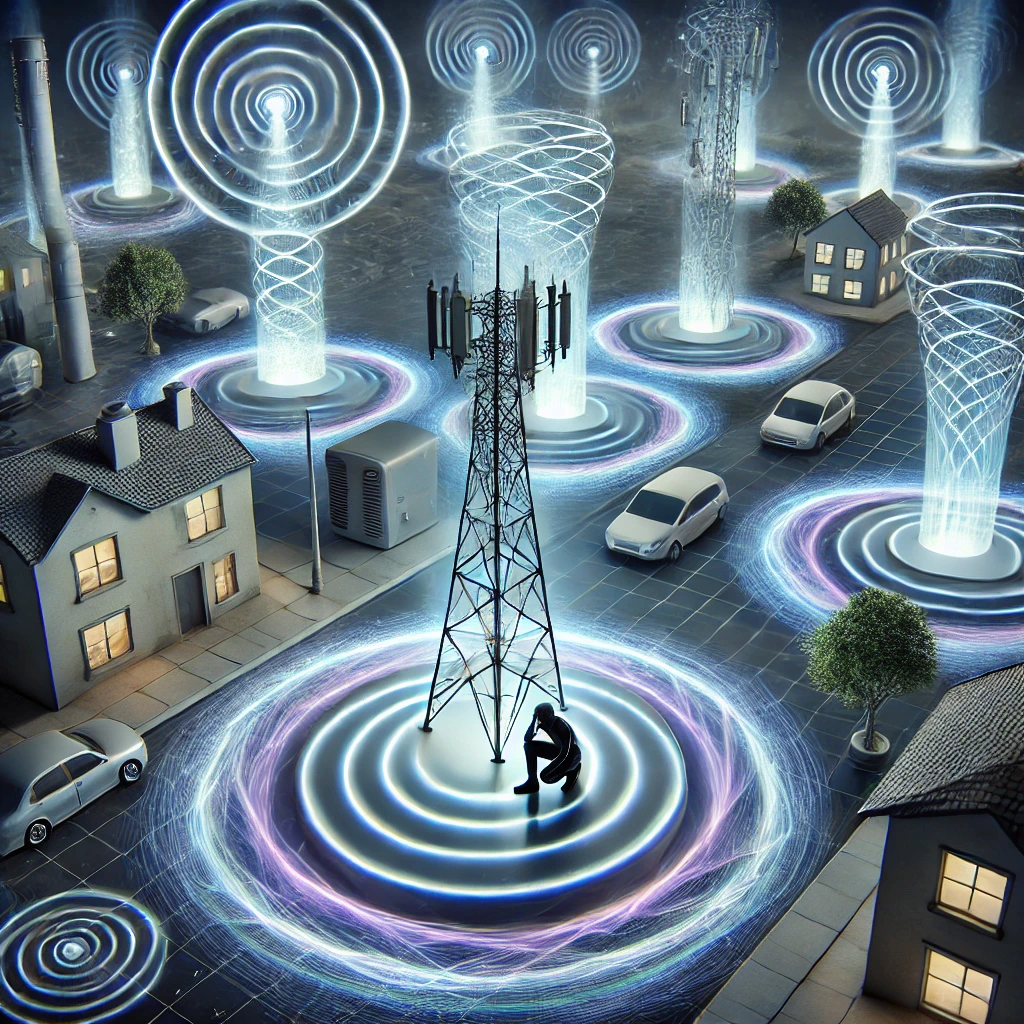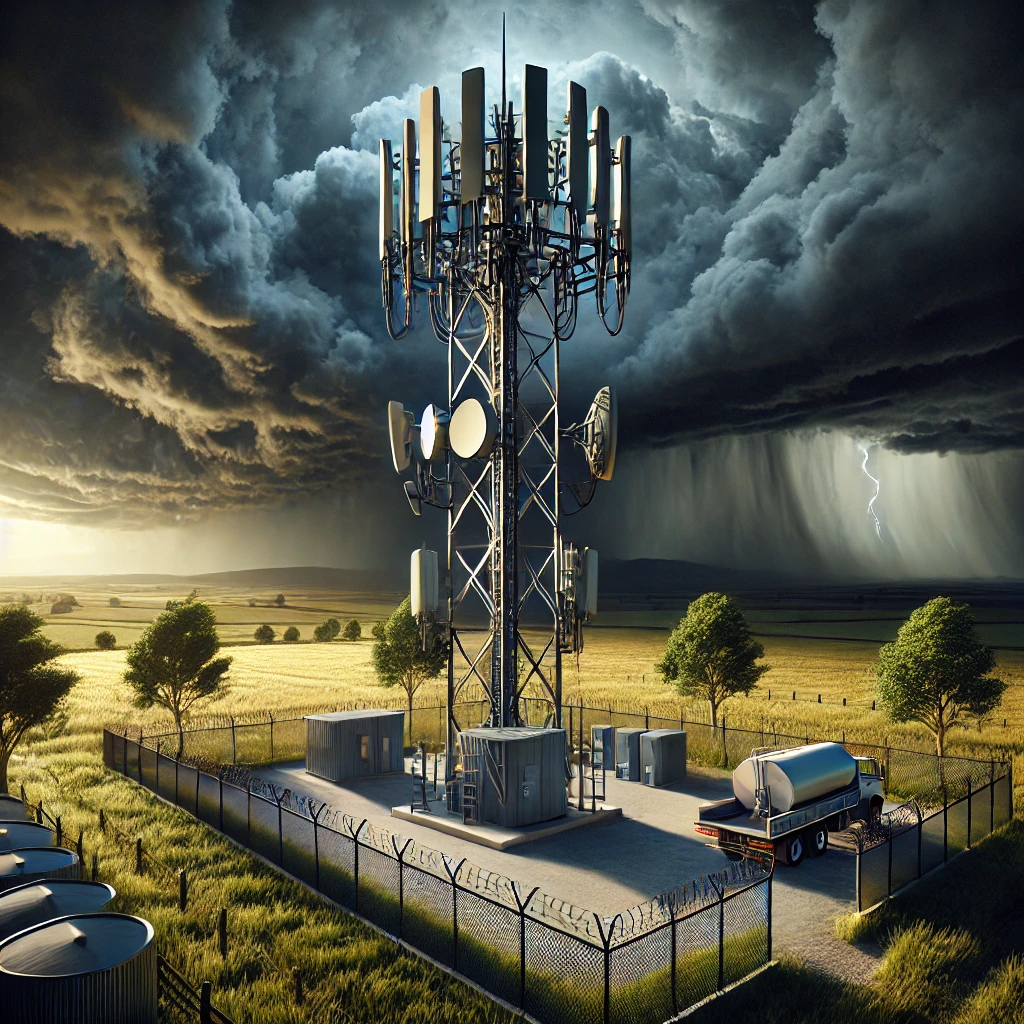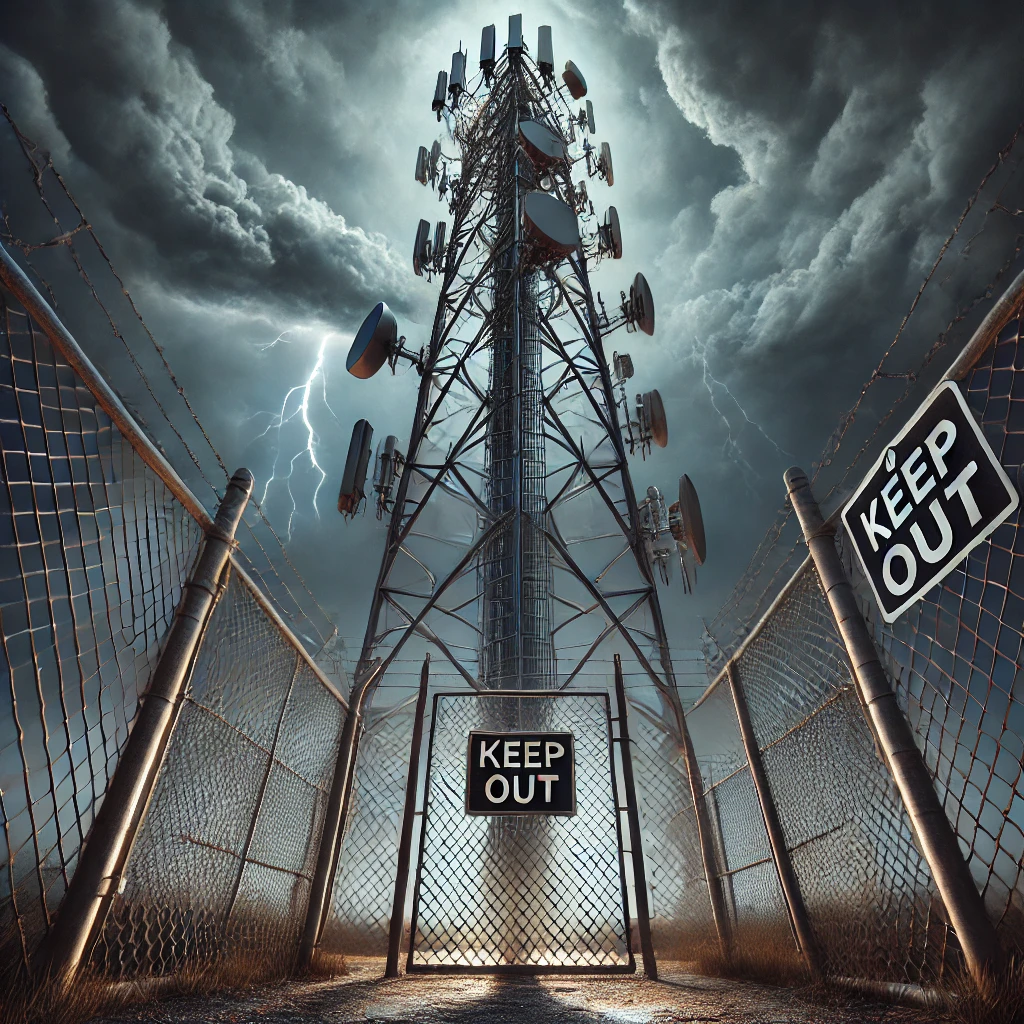Electromagnetic Fields
Over the past decade since the release of the BioInitiative 2012 Report, hundreds of additional peer-reviewed studies have been published, with the clear majority reporting biological effects rather than a lack of impact. The consistent trend in the scientific literature indicates that exposure to low-intensity Extremely Low Frequency Electromagnetic Fields (ELF-EMF), static fields, and Radiofrequency Radiation (RFR)—even at levels currently deemed safe under federal public safety limits—may pose significant health risks.
This growing body of evidence strongly supports the need for updated public exposure standards based on biological effects, as many of the reported adverse effects occur at levels thousands of times lower than current FCC limits. Comprehensive summaries, including findings related to electrohypersensitivity and DNA damage observed in comet assay studies, are available at:
🔗 https://bioinitiative.org/research-summaries/

🔹 What Are EMFs?
EMF stands for Electromagnetic Fields — invisible areas of energy, often referred to as radiation, that are associated with the use of electrical power and various forms of natural and man-made lighting and communication technologies.
Types:
Low-frequency EMFs: from power lines, household wiring, appliances.
High-frequency EMFs: from wireless devices (Wi-Fi, Bluetooth, cell phones), including RF (radiofrequency) radiation.
🔸 What Are RFs?
RF (Radiofrequency) radiation is a type of non-ionizing electromagnetic radiation in the frequency range of about 3 kHz to 300 GHz. It’s used in:
Cell phones (including 4G and 5G)
Wi-Fi routers
Bluetooth devices
Smart meters
Microwave ovens
🧬 How EMFs and RFs Interact with the Human Body
Although RFs are non-ionizing (i.e., they don’t directly damage DNA like X-rays or gamma rays), they do interact with biological tissues, especially under high or chronic exposure.
➤ Penetration Through the Skin
Lower frequencies (like 2G, 3G, Wi-Fi 2.4GHz) penetrate deeper into the body, affecting internal organs.
Higher frequencies (like 5G millimeter waves) primarily affect the skin and surface tissues, but in very dense, high-powered networks or close proximity, the energy can still disrupt nearby biological processes.
⚠️ Cellular Disruption from Higher Frequencies (e.g., 5G)
📉 1. Cell Membrane Stress
EMFs can interfere with voltage-gated calcium channels in the cell membrane, causing abnormal calcium influx.
This can lead to oxidative stress, inflammation, and impaired cellular signaling.
⚡ 2. Mitochondrial Damage
Mitochondria — the “powerhouses” of the cell — are highly sensitive to oxidative stress caused by RF exposure.
Damage to mitochondria can lead to reduced energy production (ATP), fatigue, and increased vulnerability to disease.
🧱 3. Disrupted Cellular Repair
Chronic EMF exposure can hinder the body’s natural ability to repair cellular structures.
This includes slower healing, immune suppression, and neurodegenerative stress (some studies link this to cognitive fatigue and anxiety).
🔬 Why Higher Frequencies (e.g., 5G) May Be Riskier
Shorter wavelengths = more energy concentration per area.
5G uses millimeter waves (24–100+ GHz) that interact intensely with the skin, eyes, and sweat glands.
Even if they don’t penetrate deeply, they can affect nerve endings, blood vessel regulation, and immune cells located just beneath the skin.
High-density 5G infrastructure (like small-cell antennas in urban areas) may increase constant background exposure, leading to cumulative biological stress — especially in sensitive individuals or children.
🛡️ Summary
| Term | Meaning | Interaction with Body |
|---|---|---|
| EMF | Electromagnetic field | Energy from electricity or wireless signals |
| RF | Radiofrequency radiation (a type of EMF) | Used in wireless devices; absorbed by skin and tissues |
| 5G (High-Frequency RF) | Millimeter wave radiation | Primarily affects skin, but can disrupt biological functions in nearby tissues |
EMF is the umbrella term for all electromagnetic fields. RF is one type of EMF, specifically in the radiofrequency range used for wireless communication (like Wi-Fi, Bluetooth, and cell phones). People often use “EMF” generically, but when you’re talking about wireless technology, you’re specifically referring to RF radiation. For example, the fields from power lines (ELF-EMFs) are very different in frequency and biological effect from the RF radiation from 5G towers.
🔌 EMF vs. RF: Key Differences
| Aspect | EMF (Electromagnetic Field) | RF (Radiofrequency Radiation) |
|---|---|---|
| Definition | A broad term that refers to fields of energy created by electrically charged objects | A specific type of EMF that falls within the radiofrequency range of the electromagnetic spectrum |
| Frequency Range | Includes all types: static fields, extremely low frequency (ELF), radio waves, microwaves, etc. | 3 kHz to 300 GHz (covers radio waves and microwaves) |
| Examples | – Power lines (ELF) – Household wiring – Microwaves – X-rays (high-frequency EMF) | – Cell phones – Wi-Fi routers – Bluetooth – 5G, radar, smart meters |
| Ionizing? | Can be non-ionizing (low freq) or ionizing (X-rays, gamma rays) | Always non-ionizing |
| Penetration | Varies widely: ELF penetrates deeply; higher frequencies may only affect the skin | Generally shallow (depends on frequency); 5G mmWave mostly affects skin/surface tissues |
| Biological Concern | Can include thermal and non-thermal effects May affect calcium channels, mitochondria, oxidative stress levels | A subset of EMF effects, with growing evidence of biological disruption from prolonged or intense exposure |
Scientific Citations & References
Oxidative Stress & Cellular Damage
Yakymenko I, et al. (2016). Oxidative mechanisms of biological activity of low-intensity radiofrequency radiation. Electromagnetic Biology and Medicine, 35(2), 186–202.
DOI: 10.3109/15368378.2015.1043557
Voltage-Gated Calcium Channels and EMF Sensitivity
Pall ML (2013). Electromagnetic fields act via activation of voltage-gated calcium channels to produce beneficial or adverse effects. Journal of Cellular and Molecular Medicine, 17(8), 958–965.
DOI: 10.1111/jcmm.12088
Mitochondrial Dysfunction and RF Exposure
Di Ciaula A (2018). Towards 5G communication systems: Are there health implications? International Journal of Hygiene and Environmental Health, 221(3), 367–375.
DOI: 10.1016/j.ijheh.2018.01.011
FCC Safety Guidelines
U.S. Federal Communications Commission (FCC). Radio Frequency Safety.
https://www.fcc.gov/general/radio-frequency-safety-0
EMFs and the Blood-Brain Barrier
Salford LG, et al. (2003). Nerve cell damage in mammalian brain after exposure to microwaves from GSM mobile phones. Environmental Health Perspectives, 111(7), 881–883.
PMCID: PMC1241519
➤ Conclusion
While short-term, low-level exposure to EMFs and RFs is generally considered safe by regulatory bodies, growing evidence suggests that long-term and high-frequency exposure (such as 5G) may interfere with cellular health — particularly through oxidative stress, mitochondrial disruption, and membrane instability. This makes it wise to limit unnecessary exposure when possible.
WARNING

Many studies confirm that RF (especially 5g) exposure can lead to biological changes across different systems—including the brain, gut, skin, hormones, and cells—especially involving oxidative stress, stress hormones, and neuronal activity. Though some debate the clinical significance of these findings, the results underscore the need for further safety assessments.
Both the Federal Communications Commission (FCC) and mobile phone manufacturers provide guidelines and warnings regarding exposure to radiofrequency (RF) energy emitted by wireless devices. While these advisories are often found in user manuals or device settings and may not be prominently displayed, they offer important information.
📡 FCC Guidelines on RF Exposure
The FCC regulates RF exposure from wireless devices, setting limits based on the Specific Absorption Rate (SAR), which measures the rate at which the body absorbs RF energy. In the United States, the SAR limit for mobile devices is 1.6 watts per kilogram (W/kg), averaged over one gram of tissue. Manufacturers must ensure their devices comply with these limits before they can be marketed. US EPAFederal Communications Commission
The FCC states that, at levels below these limits, there is no consistent evidence that RF exposure from wireless devices causes adverse health effects. However, they acknowledge ongoing research in this area and recommend that consumers who are concerned can take steps to reduce exposure. US EPA+6American Cancer Society+6Cancer.gov+6
📱 Manufacturer Advisories
Mobile phone manufacturers include safety information in their user manuals, often advising users to maintain a certain distance between the device and their body to ensure compliance with RF exposure guidelines. For example, some manuals recommend keeping the phone at least 5 to 15 millimeters away from the body during use.
These recommendations are based on testing procedures that simulate device usage at specific distances from the body. Using the device directly against the body without a case or holder that maintains the recommended distance could result in RF exposure levels that exceed the tested limits.Environmental Health Trust
⚠️ Legal and Regulatory Considerations
In 2015, the city of Berkeley, California, implemented a “Right to Know” ordinance requiring retailers to inform consumers about the potential health risks associated with carrying cell phones close to the body. The law was supported by public health researchers who argued that consumers have the right to be informed about RF exposure. Wikipedia
🧭 Practical Tips for Reducing RF Exposure
For individuals seeking to minimize their exposure to RF energy from mobile devices, the following practices are recommended:
Use speakerphone or hands-free devices: This increases the distance between the device and your head.
Text instead of calling: Texting reduces the duration of exposure compared to voice calls.Cancer.gov+2US EPA+2Berkeley News+2
Avoid carrying your phone against your body: Use a bag or purse instead of pockets.
Limit use when the signal is weak: Phones emit more RF energy when trying to connect to a weak signal.US EPA
Follow manufacturer guidelines: Refer to your device’s user manual for specific safety recommendations.
While short-term exposure to electromagnetic fields (EMFs)—such as those emitted by cell phones, Wi-Fi routers, or smart devices—may not present immediate, observable health risks for most individuals, growing scientific evidence indicates that EMFs can disrupt biological processes at the cellular level. Studies have shown that EMFs can influence oxidative stress, alter calcium signaling in cells, and affect circadian rhythms, even at relatively low levels of exposure.
These biological effects may not cause noticeable symptoms in the short term, but they raise valid concerns about the consequences of long-term, consistent, and intensified exposure—particularly in environments with multiple high-frequency sources (e.g., 5G transmitters, dense urban infrastructure, or close-proximity living arrangements). In such cases, the cumulative effect of constant exposure could potentially exacerbate underlying vulnerabilities or contribute to chronic health issues over time.
The key concern is not necessarily isolated exposure, but the lack of public awareness about the importance of managing EMF levels in daily life. Just as we have learned to moderate other environmental factors—like air quality, noise, and diet—there is growing consensus that EMF exposure should be approached with similar caution. Implementing simple strategies to reduce unnecessary EMF contact—such as limiting device use at night, increasing distance from signal sources, or turning off unused wireless equipment—can help individuals take a proactive stance in supporting their long-term health and well-being.
Close-up: Low-Frequency Electromagnetic Fields (LF-EMFs)

📡 1. What Are Low-Frequency EMFs?
Low-frequency EMFs are part of the non-ionizing portion of the electromagnetic spectrum. They have long wavelengths and low energy, typically in the range of:
0–300 Hz (extremely low frequency, or ELF)
🔌 2. Common Sources of Low-Frequency EMFs
These fields are generated by anything that uses or transmits alternating current (AC) electricity, including:
| Source | Description |
|---|---|
| Power Lines | High-voltage transmission lines & transformers |
| Household Wiring | Electrical circuits behind walls |
| Appliances | Refrigerators, vacuum cleaners, electric stoves, fans |
| Electronic Devices | Televisions, monitors, audio systems |
| Electric Blankets & Heating Pads | Constant low-frequency emissions near the body |
🧬 3. How LF-EMFs Interact With the Human Body
While these EMFs do not ionize atoms or molecules, they can induce weak electric currents in tissues, especially when close to the source for extended periods.
✅ Key Characteristics:
Deep Penetration: ELF fields can penetrate deeply into the body, including muscle, tissue, and internal organs.
Induced Currents: They create low-level electrical currents within the body, especially in conductive tissues (like the brain and heart).
⚠️ 4. Biological Effects and Concerns
Though the energy levels are low, chronic exposure may influence biological systems.
🧠 Nervous System:
Possible alteration of neuronal firing and neurotransmitter function
Disruption of melatonin production linked to sleep disturbances
🧬 Cellular Effects:
Increased oxidative stress
Possible changes in gene expression
In vitro studies have shown potential for DNA strand breaks
🧒 Children:
Higher absorption due to thinner skulls and developing nervous systems
Some epidemiological studies suggest a slight increase in childhood leukemia risk for those living near high-voltage power lines
📚 5. Key Scientific Studies & References
BioInitiative Report (2012)
A comprehensive review of over 1,800 studies on biological effects of EMFs.
Notes associations between ELF-EMF exposure and increased oxidative stress, DNA damage, and neurological effects.
www.bioinitiative.org
IARC (International Agency for Research on Cancer)
Classified ELF magnetic fields as “possibly carcinogenic to humans” (Group 2B) based on limited evidence in humans (childhood leukemia).
Ahlbom et al., British Journal of Cancer (2000)
Meta-analysis found a doubling of leukemia risk for children exposed to magnetic fields >0.4 μT.
Huss et al., American Journal of Epidemiology (2009)
Exposure to ELF-EMFs associated with neurodegenerative diseases like Alzheimer’s and ALS in occupational settings.
Belyaev et al., Electromagnetic Biology and Medicine (2005)
Showed changes in chromatin conformation and gene expression in response to ELF-EMFs in cell culture.
🛡️ 6. Precautionary Measures
While regulatory agencies like the WHO and FCC maintain that typical exposures are below harmful limits, some individuals prefer a precautionary approach, especially for children or vulnerable individuals.
Tips:
Increase distance from EMF sources (e.g., don’t sleep next to power strips or clocks)
Use wired connections when possible
Limit prolonged exposure to high-EMF appliances
Unplug devices when not in use
Measure EMFs using a basic gauss meter or EMF detector
Close-up: Radiofrequency (RF) Radiation

🔹 1. What Is RF Radiation?
Radiofrequency (RF) radiation is a type of non-ionizing electromagnetic radiation in the frequency range of 3 kHz to 300 GHz. It’s used extensively in wireless communication technologies.
Unlike ionizing radiation (like X-rays), RF radiation does not break molecular bonds or ionize atoms, but it can heat biological tissue and interfere with cellular processes, particularly under chronic or high-level exposure.
🔸 2. Common Sources of RF Radiation
| Device or System | Frequency Range | Purpose |
|---|---|---|
| Cell phones (2G–5G) | 800 MHz – 100+ GHz | Voice/data communication |
| Wi-Fi routers | 2.4 GHz and 5 GHz | Wireless internet |
| Bluetooth devices | 2.4 GHz | Short-range wireless communication |
| Microwave ovens | 2.45 GHz | Cooking/heating |
| Smart meters | ~900 MHz or 2.4 GHz | Utility usage tracking |
| Baby monitors, cordless phones | 900 MHz – 5.8 GHz | Audio/video monitoring |
| Radar and military equipment | 1 GHz – 100+ GHz | Surveillance and navigation |
🧬 3. How RF Radiation Affects the Human Body
📌 Penetration and Interaction
RF waves penetrate the skin and soft tissue, depending on the frequency.
Lower-frequency RF (e.g., 900 MHz) can penetrate several centimeters into the body.
Higher-frequency RF (e.g., 5G millimeter waves) are largely absorbed at or near the skin’s surface.
⚙️ Biological Effects
Even though RF radiation is non-ionizing, it can still:
Cause heating of tissue at high power levels (thermal effect)
Disrupt calcium ion channels in cells (non-thermal effect)
Induce oxidative stress, leading to free radical damage
Alter gene expression and protein folding
Affect mitochondrial function and reduce ATP energy production
⚠️ 4. Health Concerns Associated With RF Exposure
| Health Area | Reported or Studied Effects |
|---|---|
| Neurological | Headaches, fatigue, brain fog, memory issues |
| Sleep | Disruption of melatonin, insomnia |
| Cardiovascular | Heart rate variability, arrhythmia (in some sensitive individuals) |
| Reproductive | Reduced sperm motility/quality, DNA damage in sperm cells |
| Cancer | Some studies link long-term RF exposure to glioma and acoustic neuroma |
| Children & Adolescents | Higher absorption and longer lifetime exposure risk |
📚 5. Key Scientific Studies & References
National Toxicology Program (NTP) – U.S. Dept. of Health (2018)
Found “clear evidence” of RF radiation causing heart tumors (schwannomas) in male rats and DNA damage in multiple tissues.
Ramazzini Institute Study (2018, Italy)
Showed similar cancer risks (schwannomas) in rats exposed to RF radiation at far lower levels than the NTP study.
BioInitiative Report (2012, updated)
A review of over 1,800 studies showing links between RF exposure and neurological, reproductive, and cellular effects.
Pall, M.L. (2013)
Proposed that voltage-gated calcium channel (VGCC) activation is a primary mechanism for RF-induced biological effects.
Hardell & Carlberg (2015)
Epidemiological studies linking long-term mobile phone use with increased risk of brain tumors.
🛡️ 6. Practical Strategies to Reduce RF Exposure
| Tip | Why It Helps |
|---|---|
| Use speakerphone or wired headset | Keeps phone away from head |
| Keep devices out of pockets | Reduces pelvic/gonadal exposure |
| Use airplane mode when not in use | Cuts off wireless transmission completely |
| Limit Wi-Fi at night | Reduces chronic overnight exposure |
| Hardwire devices when possible | Avoids wireless radiation entirely |
| Turn off smart devices when not needed | Reduces background RF load |
🧠 Summary
| Category | Details |
|---|---|
| Type | Non-ionizing radiation (3 kHz – 300 GHz) |
| Penetration | Up to several cm (low GHz); skin-deep (millimeter waves) |
| Health Concerns | Oxidative stress, neurological symptoms, potential tumor risk |
| At-Risk Populations | Children, pregnant women, high-exposure occupations |
Close-up: High-Frequency Radiofrequency Radiation (5G and Similar RFs)

📡 1. What Is High-Frequency RF Radiation?
High-frequency RF radiation includes frequencies above 6 GHz, especially in the millimeter wave (mmWave) range of 24 GHz to 100+ GHz. This type of radiation is non-ionizing but more intense and concentrated compared to lower-frequency RFs.
It’s central to 5G networks, which use both sub-6 GHz and millimeter-wave bands to achieve faster data transmission and low latency.
📲 2. Common Sources of High-Frequency RFs (5G mmWave)
| Source | Description |
|---|---|
| 5G Small-Cell Towers | Densely placed antennas in urban areas, emitting high-frequency mmWaves |
| 5G-enabled Smartphones & Tablets | Newer models transmitting/receiving mmWave signals |
| mmWave Radar Systems | Used in vehicles, airports, and military |
| Wireless Backhaul Equipment | High-frequency relays between communication infrastructure |
🧬 3. How High-Frequency RFs Interact With the Human Body
Though these waves are non-ionizing, they interact with biological systems, especially at or near the skin’s surface.
✅ Key Characteristics:
Shallow Penetration: Millimeter waves do not penetrate deep — usually less than 1 mm into the skin.
Absorbed by the Skin, Eyes, and Sweat Glands: These areas have dense networks of nerve endings, immune cells, and capillaries, making them biologically sensitive.
Energy Density: The higher the frequency, the more energy is packed into a small space, increasing the risk of localized biological stress.
⚠️ 4. Biological Effects and Concerns
Even without ionizing tissue, 5G millimeter waves can trigger biological responses, especially with chronic or close-proximity exposure.
🧠 Nervous System:
Stimulation of skin nerve endings, potentially affecting pain receptors, thermoregulation, or the autonomic nervous system.
Disruption of calcium signaling in neurons via voltage-gated calcium channels.
🧬 Cellular Effects:
Oxidative stress and free radical formation
Damage to cell membranes and mitochondria
Possible interruption of DNA repair processes
Altered gene expression and protein folding
👶 Sensitive Populations:
Children, with thinner skin and developing organs, may be more vulnerable.
Elderly or chronically ill may have reduced detox/repair capacity.
📚 5. Key Scientific Studies & References
National Toxicology Program (2018)
Found clear evidence of RF exposure causing DNA damage and tumors in male rats.
Ramazzini Institute (2018, Italy)
Long-term exposure to low-level RF similar to cell towers linked to heart schwannomas in rats.
Pall ML (2013)
RF radiation, including from 5G, can activate voltage-gated calcium channels, leading to neurological, hormonal, and oxidative damage.
Di Ciaula A (2018)
Review suggesting 5G’s higher frequencies may increase oxidative stress, reduce fertility, and affect neurological systems.
SAGE (Scientific Advisory Group for Emergencies) – UK
Warned that millimeter waves may result in heat buildup in dense tissues and require more research before widespread rollout.
🛡️ 6. Precautionary Measures
Though 5G is still being evaluated for long-term effects, many experts advocate a precautionary approach until safety is clearly established.
Tips:
Increase distance from 5G-enabled devices and small-cell antennas
Use airplane mode when devices are idle, especially near the body
Limit children’s use of 5G-connected devices
Use wired connections whenever possible (ethernet > Wi-Fi > 5G)
Shield bedrooms or rest areas from 5G radiation (e.g., EMF shielding paint, fabrics)
Track EMF exposure with an RF meter to monitor high-exposure zones
Scientific evidence is crucial to make informed decisions

Understanding the scientific evidence is crucial for making informed decisions about electromagnetic field (EMF) exposure. While short-term exposure to electromagnetic fields (EMFs) from devices like cell phones and Wi-Fi routers may not pose immediate health risks, a growing body of research suggests that long-term, consistent, and high-level exposure could have biological effects that merit attention.
Scientific Findings on EMF Exposure
1. Oxidative Stress and Cellular Impact
Research indicates that EMF exposure can lead to oxidative stress by increasing the production of reactive oxygen species (ROS). This imbalance can damage cellular components, including DNA, proteins, and lipids, potentially leading to various health issues. For instance, a study highlighted that EMF exposure resulted in oxidative stress in multiple tissues, affecting antioxidant enzyme activities and leading to cellular damage. PMC
2. DNA Damage
Several studies have demonstrated that EMFs can cause DNA strand breaks. Using techniques like the comet assay, researchers have observed single and double-strand DNA breaks in cells exposed to EMFs. Such genetic damage is concerning because it can lead to mutations and potentially contribute to cancer development. arXivPubMed+1ScienceDirect+1
3. Cellular Changes and DNA Damage
Research indicates that EMFs can cause DNA strand breaks and affect cell proliferation. For instance, a study found that low-level microwave radiation caused DNA damage in rat brain cells. Wikipedia
4. Cancer Risk
Some epidemiological studies have observed a potential association between long-term EMF exposure and an increased risk of certain cancers, such as childhood leukemia. However, these findings are not conclusive and warrant further investigation. Cancer.gov+2World Health Organization+2Wikipedia+2
5. Childhood Leukemia
The International Agency for Research on Cancer (IARC) has classified extremely low-frequency magnetic fields as “possibly carcinogenic to humans” based on limited evidence linking them to childhood leukemia. While the evidence is not conclusive, it underscores the need for caution, especially with long-term exposure. ScienceDirect+8American Cancer Society+8The Guardian+8
6. Reproductive Health Effects
Animal studies have shown that EMF exposure can negatively impact reproductive health. For example, research on mice indicated that whole-body exposure to radiofrequency electromagnetic energy led to oxidative DNA damage in spermatozoa, reduced sperm vitality, and motility. Nature
7. Altered Gene Expression from 5G:
Repeated 5G exposure caused minor transcriptomic changes in mice brains
In this 2024 study, adult male mice were exposed to 3.5 GHz 5G signals on the head for 1 hour daily, five days a week, over six weeks. Behavioral tests (locomotion, memory) showed no changes, but gene expression analysis in brain tissue revealed:
Changes in expression of less than 1% of genes.
Altered expression of genes related to glutamatergic synapses (involved in neurotransmission).
One cortical region (with higher RF exposure) showed increased expression of genes encoded by the mitochondrial genome.
These transcriptomic shifts suggest mild biological changes, even without observable behavioral effects (Lameth et al., 2024).
This study provides early evidence that 5G exposure may alter gene expression in the brain, particularly affecting mitochondrial and neurotransmitter-related genes. However, the changes were limited in scope and did not translate into functional impairments—highlighting the need for further research.
8. Understanding the Potential Link Between EMFs and Autism
Peter Sullivan, drawing from his personal experiences and professional background in technology, has investigated how EMF exposure might impact neurological development. He emphasizes the concept of “total load theory,” which suggests that multiple environmental stressors—including EMFs—can cumulatively affect individuals, potentially leading to conditions like autism.PRWeb+1Clear Light Ventures+1
Sullivan references research indicating that EMFs may influence biological processes such as calcium signaling in cells, oxidative stress, and blood-brain barrier permeability. These disruptions could, in theory, interfere with normal neurological development and function. For instance, studies have shown that EMF exposure can lead to increased intracellular calcium levels, which may affect neuronal activity and connectivity.Poisoning Our Children
Practical Steps for Reducing EMF Exposure
Clear Light Ventures advocates for proactive measures to minimize EMF exposure, especially in environments where children are present. Some recommended strategies include:
Limiting Wireless Device Usage: Reducing the use of Wi-Fi, cell phones, and other wireless devices, particularly during sleep hours.
Creating Low-EMF Spaces: Designating areas in the home with minimal EMF exposure, such as using wired internet connections and avoiding cordless phones.
Educating Communities: Providing resources and information to schools and families about the potential impacts of EMFs and ways to mitigate exposure.
Sullivan’s approach is not to incite fear but to encourage informed decision-making regarding technology use and environmental health. By understanding and managing EMF exposure, families may be able to reduce potential risks associated with neurological development.Park Record
⚠️ Implications for Long-Term Exposure
While short-term exposure to EMFs is generally considered safe, the cumulative effects of long-term and high-level exposure are not fully understood. Factors such as proximity to EMF sources, duration of exposure, and individual susceptibility can influence potential health outcomes. Given the ubiquity of EMF-emitting devices in modern life, it’s prudent to be aware of exposure levels and consider mitigation strategies.
The Evidence can be overwhelming and uncomfortable

Changes in nervous system responses in humans
Exposure to 3.5 GHz 5G signals led to a slight increase in head and neck skin temperature and minimal modulation of electrodermal activity, possibly indicating faster nervous system responses. These changes were within normal ranges but signal a need for more research (Jamal et al., 2024).
Molecular changes in brain tissue in mice
Repeated head exposure to 3.5 GHz 5G for 6 weeks caused mild alterations in gene expression, particularly in genes linked to neurotransmission and mitochondrial activity, though no behavioral changes were observed (Lameth et al., 2024).
Cellular stress responses in lab studies
In vitro experiments show potential stress responses in excitable cells (like neurons) when exposed to 5G signals, but the findings are still early-stage and need replication (Pisano et al., 2024).
EEG brainwave changes in humans
A systematic review noted that while most studies did not find negative effects on cognition or well-being, some reported changes in EEG alpha wave activity, suggesting subtle neurological influence from 5G exposure (Sofri et al., 2022).
Thermal effects on skin from millimeter waves
Modeling studies show that higher-frequency 5G signals primarily affect superficial skin layers, with heating effects that could be relevant under high exposure, though this remains below safety thresholds (Bailey et al., 2020), (Alameddine et al., 2022).
Calls for more long-term and interdisciplinary studies
Multiple papers emphasize that existing studies do not fully address long-term or constant exposure scenarios and recommend expanded research efforts across biology and physics (Effects of 5G wireless communication on human health, 2020).
Mild effects on nervous system and skin temperature in humans
A 2024 study exposed healthy individuals to 3.5 GHz 5G signals and found slight increases in head and neck skin temperature and minimal changes in electrodermal responses—though all were within normal physiological ranges and not conclusively harmful (Jamal et al., 2024).
Transcriptomic changes in mice from repeated head exposure to 3.5 GHz 5G
A 2024 animal study showed no behavioral or memory changes in mice exposed to 5G, but did detect small gene expression changes in the brain, especially in areas related to mitochondrial activity and neurotransmission (Lameth et al., 2024).
Potential modulation of cellular stress responses
Research involving 5G-targeted exposure systems found that real-time electrophysiology tools can detect subtle changes in cell stress responses under RF exposure, though findings are still preliminary (Pisano et al., 2024).
Repeated call for further in vitro and long-term studies
Reviews highlight that while no major risks have been confirmed, current data is insufficient for ruling out non-thermal effects like oxidative stress or gene modulation. These findings support the call for more rigorous and long-term biological assessments (Pisano et al., 2023), (Suresh et al., 2023).
Critique of regulatory standards and push for 5G moratorium
Some researchers argue current safety guidelines (ICNIRP) are too lenient because they only consider thermal effects and ignore other reported biological impacts. A series of studies call for a moratorium on 5G until more rigorous risk assessments are conducted (Hardell & Carlberg, 2021), (Hardell, 2021).
Overview of EMF effects on vegetation suggests potential for harm
A 2023 review highlights that RF and 5G waves may cause both thermal and non-thermal effects on biological organisms—including plants—due to their high water content. Potential effects include altered growth, impaired cellular function, and changes in protein synthesis, although evidence is still mostly extrapolated from animal studies (Şeker & Şimşek, 2023).
Honey bee study raises ecological concerns indirectly tied to plant pollination
While not focused on plants directly, a study using 5G frequency modeling on honey bees shows possible thermal absorption effects depending on wave direction and polarization. Since bees are crucial pollinators, disruptions to their behavior or survival could negatively impact plant reproduction and ecosystems (Jeladze et al., 2022).
General environmental concerns about electromagnetic pollution
Another review notes that due to 5G’s reliance on millimeter waves, more base stations will be required, increasing ambient EMF levels. This could affect not just animals but also trees and crops, which are highly sensitive to micro-environmental changes. However, this is a theoretical concern and not yet backed by experimental plant-specific data (Kerna et al., 2021).
Impact on Honey Bees – Implications for Plant Pollination
A simulation study using 5G frequencies (2.5–100 GHz) showed that certain RF conditions could cause dielectric heating in honey bees, potentially impairing their behavior and survival. Since bees are crucial pollinators, this could indirectly harm plant reproduction and food systems (Jeladze et al., 2022).
Review of EMF Effects on Vegetation
A comprehensive review reports both thermal and non-thermal biological effects of RF radiation on plants and vegetation, noting possible disruptions to cellular function, growth, and water absorption. Millimeter waves used in 5G are highlighted as particularly concerning due to their interaction with plant tissue water content (Şeker & Şimşek, 2023).
Policy report on EMF effects on ecosystems
A 2024 policy-focused study stresses that 5G may increase RF-EMF absorption in small organisms, including plants, due to surface-level energy penetration. European stakeholders in this survey supported further funding and monitoring of potential ecological impacts (Recuero Virto et al., 2024).
General environmental effects including trees
A broad review asserts that 5G radiation, particularly due to the close proximity of new small-cell base stations, could increase electromagnetic pollution, potentially affecting trees and plants due to higher surface absorption and oxidative stress, though experimental plant-specific data is still lacking (Kerna et al., 2021).
Oxidative stress in rats from 5G exposure
Rats exposed to multi-frequency RF fields including 3.5, 28, and 37 GHz (5G frequencies) showed imbalances in oxidative stress markers like diene conjugates and catalase. These changes reflect biological stress responses and altered antioxidant defense (Perov & Lifanova, 2024).
Cellular stress responses in human skin cells
Continuous 24-hour exposure to 3.5 GHz 5G signals triggered changes in heat shock protein activity and slightly impaired stress-induced responses in fibroblasts, although keratinocytes were less affected. This shows cell-type specific stress modulation (Joushomme et al., 2023).
DNA fragmentation and membrane damage in boar sperm
In vitro exposure of boar semen to 5G RF-EMR (700, 2500, 3500 MHz) significantly increased DNA fragmentation and sperm membrane damage, suggesting possible risks to reproductive health at cellular levels (Butković et al., 2024).
Mitochondrial and ROS effects in skin cells
A study on human skin cells exposed to 3.5 GHz 5G signals observed modest reductions in mitochondrial reactive oxygen species (ROS) in fibroblasts and increased sensitivity to UV-induced stress in keratinocytes (Patrignoni et al., 2023).
Transcriptomic alterations in mice brains
Mice exposed repeatedly to 3.5 GHz 5G for 6 weeks showed subtle changes in gene expression, particularly involving neurotransmission and mitochondrial genes—even though no behavioral differences were found (Lameth et al., 2024).
Concerns about biological tissue heating and shallow penetration
A broad review of EMF effects notes that 5G’s shallow penetration due to millimeter waves may disproportionately affect skin and eye tissues. Alterations in cell division and nervous system signaling are theorized, though more data is needed (Şeker & Şimşek, 2023).
Disruption of gut microbiota and metabolism in mice
Exposure to 4.9 GHz 5G for 1 hour/day over 3 weeks significantly altered gut microbial diversity and fecal metabolite profiles in mice, suggesting that 5G RF exposure may influence gut health and metabolism (Wang et al., 2024).
Neuroendocrine disruption in rats
Chronic 5G-like RF exposure (24/7 for 4 months) in rats led to elevated stress hormone levels (ACTH, corticosterone), indicating stress-related activation of the hypothalamic–pituitary–adrenal axis (Perov et al., 2022).
Oxidative stress in blood from 5G exposure
Rats exposed to 3.5–37 GHz RF showed altered levels of oxidative stress markers, including increased pro-oxidant concentrations and changes in antioxidant enzyme activity (Perov & Lifanova, 2024).
Altered mitochondrial stress responses in human skin cells
Human fibroblasts exposed to 3.5 GHz RF for 24 hours showed reduced mitochondrial ROS production and altered sensitivity to UV-induced damage, suggesting subtle shifts in oxidative stress handling (Patrignoni et al., 2023).
Stress-related molecular changes in skin cells
5G RF exposure influenced signaling proteins like HSF1, ERK, and PML in fibroblasts, although results were inconsistent across exposure types and cell lines (Joushomme et al., 2023).
Inhibition of neuronal activity in vitro
Neuronal cultures exposed to high specific absorption rates (SAR) of 3.5 GHz 5G signals showed suppressed neuronal firing and bursting, suggesting potential impacts on brain electrical signaling at high exposures (Canovi et al., 2023).
Comprehensive review of systemic biological effects
A review summarizes evidence that 5G RF may affect nervous, immune, cardiovascular, and reproductive systems, including potential genotoxic and oxidative effects across human and animal studies (Kerna et al., 2021).
Smart Moves to Mitigate Potential Health Problems

🛡️ Practical Steps to Mitigate EMF Exposure
Given these findings, it’s prudent to take steps to minimize unnecessary EMF exposure:
-
Maintain Distance: Keep devices like cell phones and Wi-Fi routers at a distance when not in use.
-
Use Wired Connections: Opt for wired internet connections to reduce exposure from Wi-Fi signals.New York Post
-
Limit Usage: Reduce the time spent on devices emitting EMFs, especially for children.Wikipedia
-
Turn Off Devices: Switch off electronic devices when not in use, particularly during sleep.
-
Use EMF Shields: Consider using EMF shielding products for devices and living spaces.
-
Turning off the 5 GHz (5G) frequency band on a typical home Wi-Fi router is usually a simple process, and it can often be done in just a few minutes via the router’s admin settings. Here’s a general step-by-step guide:
🔧 How to Turn Off 5 GHz Wi-Fi (a.k.a. 5G) on Most Routers
✅ Note: This disables the 5 GHz wireless band, not 5G cellular data. These are different technologies, despite the similar name.
Step 1: Access Your Router’s Admin Page
-
Make sure your device is connected to your Wi-Fi network.
-
Open a browser and type your router’s IP address into the address bar:
-
Common ones: 192.168.1.1 or 192.168.0.1 or 10.0.0.1
Press Enter.
-
Step 2: Log In
-
Use the admin username and password. It may be printed on a sticker on the router.
-
If you’ve never changed it, try admin/admin or admin/password.
Step 3: Locate Wireless Settings
-
Look for sections like:
-
“Wireless Settings”
-
“Advanced Settings”
-
“Wi-Fi”
-
“Dual Band Settings” or “Wireless Band”
-
Step 4: Disable 5 GHz Band
-
You’ll usually see two bands:
-
2.4 GHz
-
5 GHz
-
-
Simply uncheck or toggle “Enable 5 GHz” to OFF.
-
Click Apply or Save.
📝 A Few Notes:
-
You can leave the 2.4 GHz band on, which still provides internet access—just a bit slower but with better range.
-
Devices previously connected to the 5 GHz band will automatically switch to the 2.4 GHz one if available.
-
Some routers allow you to name the two bands differently so you can choose which one each device connects to.
-
Balancing the benefits of modern technology with potential health considerations is essential. By staying informed and adopting practical measures, you can enjoy technological conveniences while minimizing potential risks associated with EMF exposure. While technology offers numerous conveniences, being mindful of EMF exposure and taking proactive steps can help mitigate potential health risks associated with long-term exposure.
Electromagnetic Hypersensitivity

The term commonly used by healthcare professionals to describe symptoms attributed to electromagnetic field (EMF) exposure is Electromagnetic Hypersensitivity (EHS). This condition is also referred to as Idiopathic Environmental Intolerance attributed to Electromagnetic Fields (IEI-EMF).re-origin | reset, rewire, re-discover+3Wikipedia+3PMC+3
Individuals reporting EHS experience a range of nonspecific symptoms—such as headaches, fatigue, dizziness, and cognitive difficulties—that they associate with exposure to EMFs from sources like cell phones, Wi-Fi routers, and other electronic devices. However, it’s important to note that EHS is not recognized as a medical diagnosis, and scientific studies have not established a consistent link between EMF exposure and these reported symptoms. The World Health Organization (WHO) acknowledges the reality of the symptoms but states that there is no clear diagnostic criteria or scientific basis to link them to EMF exposure. re-origin | reset, rewire, re-discover+1Wikipedia+1Healthline+2Wikipedia+2Wikipedia+2World Health Organization+1Wikipedia+1
Despite the lack of scientific consensus, some individuals, such as chiropractor Russell Kort—known as “DoctorEMF”—advocate for greater awareness of EMF-related health concerns. Kort claims to experience symptoms like brain fog and disorientation when exposed to wireless technologies and promotes practices to reduce EMF exposure. While these accounts are anecdotal and not universally accepted in the medical community, they highlight the ongoing debate and the need for further research into the potential health effects of long-term EMF exposure. New York Post
EMR Syndrome

“EMR Syndrome” (Electromagnetic Radiation Syndrome) is an unofficial term sometimes used in alternative health circles and by EMF-aware practitioners to describe a cluster of symptoms believed to be caused by overexposure to electromagnetic radiation (EMR), particularly from modern sources such as:
Wi-Fi routers
Cell phones and towers (especially 5G)
Bluetooth devices
Smart meters
Household electronics
What It Refers To:
EMR Syndrome is not currently recognized by mainstream medicine or included in official diagnostic manuals (e.g., DSM or ICD). However, it is often used interchangeably or as a more specific offshoot of Electromagnetic Hypersensitivity (EHS) or Idiopathic Environmental Intolerance attributed to Electromagnetic Fields (IEI-EMF).
Reported Symptoms Typically Include:
Brain fog or cognitive fatigue
Insomnia or disrupted sleep
Headaches
Tinnitus (ringing in the ears)
Heart palpitations or anxiety
Skin burning or tingling sensations
Muscle weakness or fatigue
Visual disturbances
Mood swings or depression
Medical Recognition:
As of now:
The World Health Organization (WHO) acknowledges that people report real symptoms, but no scientific evidence consistently links them to EMF exposure under controlled conditions.
EMR Syndrome is largely considered a descriptive or advocacy term, used to draw attention to growing concerns over chronic exposure to non-ionizing radiation.
Why It Matters:
Even without formal recognition, the use of terms like EMR Syndrome underscores the need for further study and awareness—especially as global exposure to EMFs increases due to technological proliferation (e.g., 5G infrastructure, smart homes, wearable tech).
EMF-Aware Organizations, Practitioners & Networks

Here are several organizations and practitioners specializing in EMF-aware healthcare approaches:
🏥 Organizations & Networks
Environmental Health Trust (EHT)
A nonprofit organization focused on educating the public about environmental health hazards, including EMF exposure.
Provides a comprehensive directory of EMF resources and research.
Website: ehtrust.orgemfaware.ca+2Environmental Health Trust+2Substack+2
EMF Safety Network
A collective dedicated to educating and empowering people by providing science and solutions to reduce EMFs.
Offers resources and advocacy for those affected by EMF exposure.
American Academy of Environmental Medicine (AAEM)
An organization that provides education and training for physicians in environmental medicine, including EMF-related health concerns.
Hosts conferences and provides resources on evaluating and treating patients with EMF-associated illnesses.
Website: aaemonline.orgtheemfguy.helpscoutdocs.comemfsafetynetwork.org+4aaemonline.org+4theemfguy.helpscoutdocs.com+4
Physicians for Safe Technology
A group of medical professionals advocating for safer technology use and increased awareness of EMF health effects.
Organizes conferences and provides educational materials for healthcare providers.
Website: mdsafetech.orgWikipedia+4Physicians for Safe Technology+4aaemonline.org+4
👩⚕️ EMF-Aware Practitioners
Dr. Neil Nathan
A physician specializing in complex medical conditions, including EMF sensitivity.
Offers consultations and has published works on environmental medicine.
Dr. Eric Gordon
Practices at Gordon Medical Associates in California, focusing on chronic illness and environmental sensitivities.
Website: gordonmedical.com
Dr. Stephanie McCarter
Based in South Carolina, she specializes in environmental medicine and EMF-related health concerns.
Center for New Medicine
Led by Dr. Leigh Erin Connealy, this center addresses EMF sensitivity among other environmental health issues.
Website: cfnmedicine.comcfnmedicine.com
🧰 Additional Resources
EMF Aware
Provides professional home EMF inspections and assessments.
Offers resources and screening tools for health practitioners.
The EMF Guy
Offers a list of EMF-aware physicians and resources for those experiencing EMF sensitivity.
Clear Light Ventures is a prominent organization dedicated to raising awareness about the potential health impacts of electromagnetic fields (EMFs) and promoting strategies to mitigate exposure. Founded in 2007 by Peter Sullivan, a former software designer and U.S. Navy pilot with a Master’s in Computer Science from Stanford University, Clear Light Ventures focuses on environmental health, particularly the effects of toxins and wireless safety . Sullivan’s personal experiences with mercury poisoning and high levels of EMF exposure have fueled his commitment to this cause.Clear Light Ventures+4Building Biology Institute+4Everand+4Clear Light Ventures+1Everand+1
EMF and Sleep: The organization highlights the link between EMF exposure and sleep disturbances, offering resources to create healthier sleep environments .Clear Light Ventures
Autism and Wireless Exposure: Clear Light Ventures explores the potential connection between wireless radiation and autism spectrum disorders, providing information and strategies for reducing exposure .PRWeb+2Clear Light Ventures+2Clear Light Ventures+2
Educational Resources: They offer articles, videos, and tools to help individuals understand and mitigate EMF exposure in daily life.
Peter Sullivan actively participates in conferences and discussions related to environmental health, sharing insights on the biological effects of EMFs and advocating for safer technology practices .Everand+11Building Biology Institute+11Art19+11
For more information and resources, you can visit their official website: clearlightventures.com
Tools to Detect EMF Exposure

🧭 1. Handheld EMF Meters (Most Accurate)
These are professional-grade tools that detect and measure electric fields, magnetic fields, and RF radiation (including 5G if capable).
✅ Recommended Models:
| Device | Detects | Notes |
|---|---|---|
| Safe and Sound Pro II | RF, 5G (up to 8 GHz) | High accuracy, widely trusted by EMF consultants |
| Acoustimeter AM-10 | RF radiation (200 MHz to 8 GHz) | Detects Wi-Fi, Bluetooth, 4G, 5G |
| TriField TF2 Meter | Electric, magnetic, and RF fields | Covers 5G sub-6 GHz (not mmWave), very user-friendly |
| Cornet ED88T Plus | Electric, magnetic, and RF | Affordable all-in-one EMF meter |
| EMFields Acoustimeter AM-11 | RF radiation | Good sensitivity and visual/auditory output |
⚠️ Note: Most consumer meters can detect 5G in the sub-6 GHz range, but mmWave 5G (24–100+ GHz) requires more advanced, expensive equipment (and is mostly used in major urban areas and specific indoor deployments).
📱 2. Smartphone Apps
Apps can show nearby antennas or use your phone’s sensors (though not RF-accurate like meters).
📡 Antenna Locator Apps:
These help locate 5G/4G/3G cell towers and small cells near you.
| App | Platform | Features |
|---|---|---|
| Network Cell Info Lite | Android | Shows nearby towers, signal strength, some frequency info |
| OpenSignal | Android / iOS | Map of nearby antennas, signal quality per carrier |
| CellMapper | Android | Detailed tower locations, carrier-specific data |
| EMF Detector | Android | Uses magnetometer; more useful for electric/magnetic EMFs, not RF |
| Electrosmart | Android | Estimates RF exposure levels from connected devices (not highly accurate) |
⚠️ Note: Smartphone apps do not measure 5G mmWave or high-frequency RF directly — only external tower locations and your device’s own signal use.
🌐 3. Online Antenna Maps & Tools
🗺️ USA
AntennaSearch.com: Tower and antenna maps for any address in the U.S.
FCC Antenna Structure Registration: Official government tower database.
🌍 Worldwide
CellMapper.net: Global tower mapping by community input.
Opensignal.com: Carrier coverage maps with performance testing.
🧠 Pro Tips:
For RF and 5G detection, prioritize meters over apps.
Measure during peak usage times (mid-day or early evening).
Always measure in multiple locations (desk, bed, car, etc.).
For 5G mmWave detection, look for meters that specify 24 GHz+ coverage (most consumer meters stop at 8–10 GHz).
Does the risk increase as the number of EMFs increases?

Based on existing peer-reviewed scientific research, a person working in an environment—such as a more heavily populated area—receiving exposure to multiple overlapping 5G signals (or high-density radiofrequency (RF) sources), could be at increased risk for oxidative stress and related biological effects.
🧬 What the Research Suggests:
🔹 1. Oxidative Stress
Many studies—including those reviewed in the BioInitiative Report and published by researchers like Yakymenko et al. (2016)—have concluded that RF radiation, including from sources like Wi-Fi, 4G, and 5G, increases oxidative stress in cells.
-
Oxidative stress occurs when the body’s antioxidant defenses are overwhelmed by reactive oxygen species (ROS), leading to cellular damage, inflammation, and potentially chronic disease.
-
This effect has been seen at non-thermal exposure levels—i.e., without heating tissue, which is how traditional safety standards are set.
📘 “Oxidative mechanisms of biological activity of low-intensity radiofrequency radiation.” (Yakymenko et al., 2016, Electromagnetic Biology and Medicine)
https://doi.org/10.3109/15368378.2015.1043557
🔗
🔹 2. Cumulative Load Matters
While one single RF source might not cause measurable harm, studies suggest that cumulative exposure from multiple, simultaneous RF sources—especially in high-density urban environments—can contribute to:
-
Elevated oxidative stress
-
Disrupted calcium signaling in cells
-
Mitochondrial dysfunction
-
Immune dysregulation
-
Changes in gene expression
This is a concern particularly in densified 5G environments, where small-cell antennas are located indoors or just outside buildings, emitting frequent, high-frequency bursts of data.
🔹 3. Distance and Intensity
RF exposure increases sharply with proximity and number of sources. So, being within several feet of numerous Wi-Fi routers, cell phones, smart devices, and nearby small-cell 5G antennas—all transmitting simultaneously—creates an electromagnetic environment far more intense than that in rural or low-tech areas.
🧠 Summary:
✅ According to the research, yes — being exposed to high volumes of overlapping 5G signals (or other RF sources) could increase biological oxidative stress, particularly:
-
With prolonged exposure (daily, over months/years)
-
When other sources (Wi-Fi, Bluetooth, nearby antennas) are also present
-
If the individual has reduced antioxidant defenses or preexisting sensitivities
🔧 Practical Precautions:
-
Use wired internet when possible.
-
Turn off Bluetooth or Wi-Fi functions when not in use.
-
Avoid sitting directly next to a Wi-Fi router or small-cell antenna.
-
Use EMF shielding materials for your work area (fabrics, paint, or desk shields).
-
Support your body’s natural defenses with antioxidants (diet, supplements like glutathione or magnesium).
